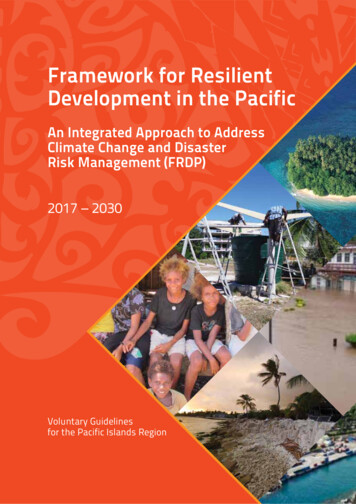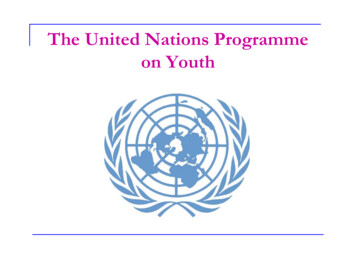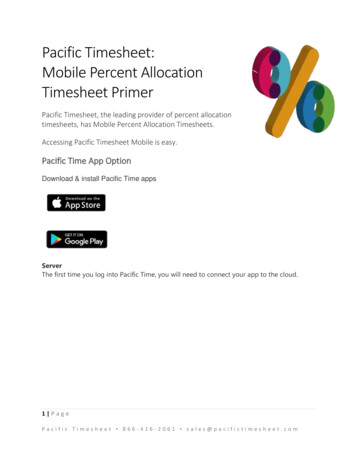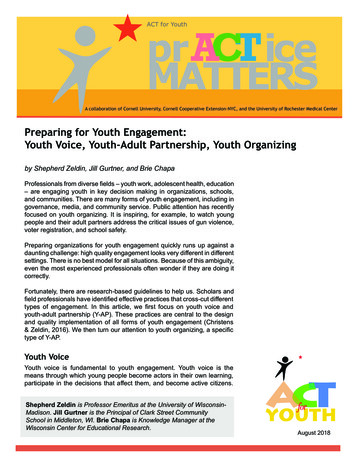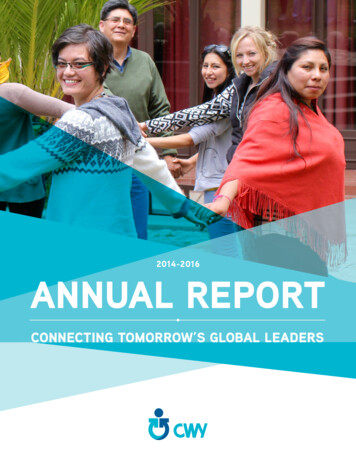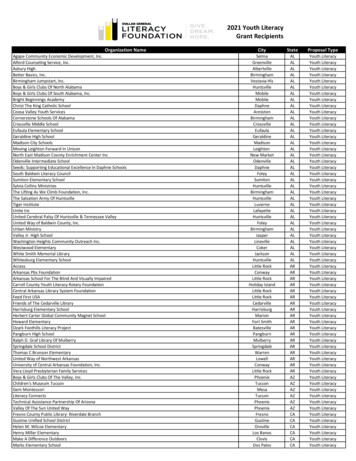
Transcription
The Pacific Youth Development Framework 2014–2023The Pacific Youth Development Framework2014–2023A coordinated approach to youth-centreddevelopment in the PacificSecretariat of the Pacific CommunityA coordinated approach to youth-centred development in the PacificA
Cover photo: Students in Tailevu, Fiji, World Water Day, 2014.
The Pacific Youth Development Framework2014–2023A coordinated approach to youth-centreddevelopment in the PacificPrepared by the Social Development Division of theSecretariat of the Pacific CommunitySuva, Fiji 2015i
The Pacific Youth Development Framework 2014–2023 Copyright Secretariat of the Pacific Community (SPC) 2015All rights for commercial/for profit reproduction or translation, in any form, reserved. SPC authorises the partialreproduction or translation of this material for scientific, educational or research purposes, provided that SPCand the source document are properly acknowledged. Permission to reproduce the document and/or translatein whole, in any form, whether for commercial/for profit or non-profit purposes, must be requested in writing.Original SPC artwork may not be altered or separately published without permission.Original text: EnglishSecretariat of the Pacific Community cataloguing-in-publication dataThe Pacific Youth Development Framework 2014–2023: a coordinated approach to youth-centred developmentin the Pacific / prepared by the Social Development Division of the Secretariat of the Pacific Community.1. Youth – Oceania.2. Youth – Social aspects – Oceania.3. Youth – Economic aspects – Oceania.4. Youth in development – Oceania.I. Title II. Secretariat of the Pacific Community305.2350995ISBN: 978-982-00-0910-3Prepared for publication at SPC’s Suva Regional Office, Private Mail Bag, Suva, Fiji, 2015Printed by Quality Print Limited at Suva, Fiji, 2015Secretariat of the Pacific CommunitySocial Development DivisionPrivate Mail Bag, GPO Suva, FijiEmail: spc@spc.intwww.spc.intiiA coordinated approach to youth-centred development in the PacificAACR2
The Pacific Youth Development Framework 2014–2023ContentsAcknowledgements. 2Foreword. 3Abbreviations. 4Rationale.5Background. 7Strategic approaches. 9The Pacific Youth Development Framework (PYDF) 2014–2023. 13Vision. 14Mission. 15Principles. 16Development outcomes for youth. 18Strategic approaches. 21PYDF priority outcome areas. 23Implementation mechanisms. 38Monitoring and evaluation. 43Annex 1: Excerpts from regional declarations.48Annex 2: Target key populations of youth. 51A coordinated approach to youth-centred development in the Pacific1
The Pacific Youth Development Framework 2014–2023AcknowledgementsThe Pacific Youth Development Framework (PYDF) 2014–2023 is a collaborative effortby youth stakeholders, consisting of regional and national development agencies, youthnetworks, and governments and administrations. The process of development has beenguided by a steering committee with representatives from the Commonwealth YouthProgramme, International Labour Organization, United Nations Educational, Scientificand Cultural Organization, United Nations Children’s Fund, United Nations DevelopmentProgramme, United Nations Population Fund, Oceania Football Confederation, PacificYouth Council, the University of the South Pacific, and the Pacific Islands Forum Secretariat.Other stakeholders with an interest in PYDF outcome areas have contributed to countryconsultations and the shaping of implementation strategies.Initial phases of development were financially supported by the Australian government throughthe Pacific Leadership Program. Innovate Change consultants, Simon Harger-Forde andDebbie Edwards, led the initial phases of development and prepared drafts of the PYDF forconsultation. The Commonwealth Youth Programme provided consultation space during the2013 Commonwealth Youth Ministers Meeting in Papua New Guinea. The 2013 ministerialmeeting was supported by the Oceania Football Confederation, the New CaledonianAdministration and the Secretariat of the Pacific Community. The overall development of thePYDF was led by the Secretariat of the Pacific Community’s Social Development Division andStrategic Engagement Policy and Planning Facility, coordinated by the Youth Advisor, MereiaCarling. All of these have had significant influence on the development of the PYDF. Thesecontributions are gratefully acknowledged.The design and layout has been done by Sailesh Kumar Sen, Geoscience Division of SPC.2A coordinated approach to youth-centred development in the Pacific
The Pacific Youth Development Framework 2014–2023ForewordThe Pacific Youth Development Framework 2014–2023 represents an important milestonefor the Pacific region. It responds to the calls from young people, development partnersand governments for greater support for the implementation of countries’ youth policies,and to address barriers to progress. In 2013 Pacific ministers for youth endorsed fouroutcome areas, as set out in this framework, as well as key steps for their implementation.The implementation strategies that have since been developed take into account both thecapacities of governments and their existing collaborations with development partners andyouth representative structures.The framework aims to be a catalyst for investment in youth, rather than a regional youthprogramme. It aims to facilitate shared decision-making based on evidence and contributionsfrom relevant communities of practice, and to support Pacific Island countries and territoriesin implementing their development objectives for youth. The framework must strengthen theway we collect data to understand the circumstances of youth in the Pacific, and it mustposition youth at the forefront of this movement to ensure that they have an opportunityto influence decisions that affect them. Furthermore, with young people at the helm ofthese important discussions, we can nurture partnerships between youth, governments,administrations and development partners that seek all perspectives and work to meetdevelopment challenges in the best interests of youth and Pacific communities.The framework, and its responsibilities for regional coordination, is shared by the Secretariatof the Pacific Community (SPC) and the Pacific Youth Council. While SPC has led theprocess of development thus far, the Pacific Youth Council is the regional body representing10 national youth council bodies in the Pacific, which, in turn, represent provincial youthcouncils in member countries. So there is a unique opportunity for development agenciesand governments to engage young people in development and to create space for youngpeople to exercise leadership in contributing to the framework.Together, we commit to embracing the framework’s objectives to engage Pacific youth inleading change towards the framework’s vision: A sustainable Pacific where all youngpeople are safe, respected, empowered and resilient.Dr Colin TukuitongaMr ’Alaipuke EsauDirector-GeneralSecretariat of the Pacific CommunityChair of Executive BoardPacific Youth CouncilA coordinated approach to youth-centred development in the Pacific3
The Pacific Youth Development Framework 2014–2023Abbreviations4AIDSacquired immune deficiency syndromeHIVhuman immunodeficiency virusILOInternational Labour OrganizationLGBTlesbian, gay, bisexual and transgenderNCDnon-communicable diseaseNEETyoung people who are not in education, employment or trainingPICTPacific Island countries and territoriesPRYTTPacific Regional Youth Think TankPYCPacific Youth CouncilPYDFPacific Youth Development FrameworkSPCSecretariat of the Pacific CommunityA coordinated approach to youth-centred development in the Pacific
The Pacific Youth Development Framework 2014–2023RationaleThe Pacific Youth Development Framework (PYDF) recognises and responds to officialacknowledgements made by Pacific Island leaders and ministers1 who have convened atseveral recent high-level regional forums and endorsed the position of youth and the needfor a regional framework as a priority in the regional development agenda (see Annex 1for relevant excerpts). Specifically, Pacific ministers of youth and sports have endorsed theproposed shape and process of the PYDF at the Third Meeting of Pacific Ministers of Youthand Sport, held in New Caledonia on 7 December 20132.The proclamations are based on a recognition and understanding of the situation of youthin the Pacific and the need for a coordinated approach to promote priority youth issueswith greater emphasis in regional and national development agendas. More than half of theregion’s population of 10 million, across 22 countries and territories, is under the age of 25.This segment of the population is growing fast, placing huge and increasing demographicpressures on basic resources and core services. Average youth unemployment rates in thePacific are 23%3 compared with a global average of 12.6%4. Despite the substantial size of theyouth population in the region and the significance of issues such as youth employment andyoung people’s sexual and reproductive health, there remains a lack of targeted investmentrequired to meet the needs of all young people in the Pacific. The resulting impact has beenminimal change in the overall status of youth since 2005–20115.A concerning and significant proportion of the youth population is marginalised frommainstream development efforts, which has created development burden and hindered theregion’s progress. Key youth populations marginalised from mainstream development effortsinclude: young people who are not in education, employment and training; young women; rural youth; young people with disabilities; youth who are discriminated against because of their sexual orientation or genderidentity and expression.With little systematic engagement of youth and a marginalisation of key youth populations,youth disenfranchisement can lead to many negative consequences6. Increased targeted1Pacific Islands Leaders Forum,. 2012; Leaders’ Communiqué, Cook Islands 2012; EighthCommonwealth Youth Ministers Meeting, 2013; Final Communiqué, Papua New Guinea, 2013.2Third Meeting of the Pacific Ministers of Youth and Sport, 2013. Communiqué. New rnational Labour Organization. 2013. Global employment trends for youth 2013. A generationat risk. Geneva: International Labour Office.5United Nations Children’s Fund and Secretariat of the Pacific Community. 2011. The state ofPacific youth report 2011: Opportunities and obstacles. United Nations Children’s Fund – Pacificand Secretariat of the Pacific Community6Noble C. and Pereira N. 2011. Urban youth in the Pacific: Increasing resilience and reducing riskfor involvement in crime and violence. United Nations Development Programme – Pacific Centre.2011. Study prepared for the Forum Regional Security Council.A coordinated approach to youth-centred development in the Pacific5
The Pacific Youth Development Framework 2014–2023investment in these key youth populations to address priority youth development issues willbenefit Pacific communities as a whole. Such investment is vital for sustainable developmentand is shown to have greater economic benefit7.The Review of the Pacific Youth Strategy (Secretariat of the Pacific Community 2010),the State of Pacific Youth Report (United Nations Children’s Fund and Secretariat of thePacific Community 2011) and the Urban Youth Report 2011 (United Nations DevelopmentProgramme 2011) are key documents that have informed the development of the PYDF.The State of Pacific Youth Report 2011, launched at the Pacific Islands Leaders’ Forumin Auckland 2011, determined that very little change had occurred since 2005. It notedthat while some young people had improved education and access to improved healthand other services, of concern was a significantly sized population of youth who remained,due to various vulnerabilities and discriminations, lacking in access to these services. Forthese young people, their situation was deemed more critical than the baseline in 2005,due to the compounding pressures of the global economic crisis. The report stated ratherconfrontationally, ‘Without major investment in young people, they may well flounder as ageneration, undermining the capacity of Pacific Island countries and territories to escape aiddependence and develop economically8.’ Youth stakeholders have recognised that a changeto the way the region addresses youth is urgently required.Improved statistical data and analysis on youth is critical to identify gaps and provideevidence to guide investments — many Pacific Island countries and territories (PICTs) do notmeasure youth unemployment with international standards, which vastly underestimates thereal situation. Much census and national survey data are not analysed to determine youthprofiles. Without hard evidence, ‘youth’ is still considered a ‘soft’ issue.Youth issues are often treated as stand-alone issues, unconnected to other issues, andoften without addressing root causes. As both a cross-cutting and a multi-sectoral issue,coordination is essential to ensure that all aspects of youth development are addressedand monitored across sectors and to bring a focus on youth and youth engagement to newsectors. National youth policies need to be implemented across a range of ministries andneed high-level commitment from core ministries.A key reason that has been attributed to previous lack of implementation is the lack ofcommitment and engagement of partners, governments and young people. Without aregular high-level forum for making decisions about youth, there is little developmentaccountability to deliver on youth. The review of the previous strategy recommended theestablishment of a strong mechanism for regional cooperation and regular cross-governmentprogress reporting. In a resource-scarce environment, regional coordination is important toavoid duplication of efforts and to work collaboratively, sharing resources more equitably tomeet resource gaps.67United Nations Population Fund. 2015. The State of World Population 2014. New York: UnitedNations Population Fund.8United Nations Children’s Fund and Secretariat of the Pacific Community. 2011. The state ofPacific youth report 2011: Opportunities and obstacles, p. 5. United Nations Children’s Fund –Pacific and Secretariat of the Pacific Community.A coordinated approach to youth-centred development in the Pacific
The Pacific Youth Development Framework 2014–2023BackgroundThe predecessor to the PYDF was the Pacific Youth Strategy 2005–2010. It featured sevencomponents designed to produce positive outcomes for young people, including accessingintegrated education, nurturing sustainable livelihoods, promoting healthy lifestyles, andresearching information and data on youth. The end review of its implementation andeffectiveness in 2011 highlighted significant challenges that had hindered its success.The review of the Pacific Youth Strategy 2005–2010 revealed a low uptake from countries andterritories; few youth policies had made any reference to the regional strategy. Implementationof national youth policies was generally still slow and under-resourced. National stakeholdershad been challenged by needing to reflect alignment to the regional strategy in their youthpolicies, while also needing to represent local issues and responses. The State of PacificYouth Report 2011, as mentioned above, revealed very little change in the situation of youthsince 2005. It recommended a greater focus in three areas:1. improving governance for youth — coordinating regional strategies for scaling upyouth programs targeted at key populations;2. improving data collection and analysis of youth — monitoring of established youthmeasures; and3. mobilising resources for youth — making resources available to support youthprogramming.These two key documents provided the basis for regional and development agencies,governments and administrations, and young people to reconsider the purpose of regionalstrategic frameworks, if these were to lead to change and development progress, inclusiveof young people. The Secretariat of the Pacific Community (SPC), responsible for developingthe regional strategy, convened all stakeholders to discuss the issue of how previousstrategies had not been implemented as expected, and attempted to resolve the questionof how countries, development agencies and young people could create real change in thelives of young Pacific Islanders.Eighteen months of rigorous consultation and a participatory process of strategic developmentensued. Stakeholders determined that an effective regional strategic framework was indeedneeded, despite the lack of success with the previous one. A regional framework neededto support countries to implement their own youth policies rather than enforce alignmentwith the regional framework, and needed to address the specific barriers to implementation.In doing so, it must: 1) provide guidance on how to measure and monitor the situationof youth; 2) engage and have commitment from development agencies and governmentsand administrations; 3) reach the right youth (i.e. youth who are missing out on mainstreamdevelopment efforts); and 4) be informed by the voices of youth throughout its process.During this time, a PYDF Steering Committee, comprising representatives from developmentagencies and youth networks, provided oversight and guidance to the development ofthe framework and other strategic initiatives aimed at nurturing an enabling environment.Youth stakeholders worked in solidarity to promote regional commitment towards youthand the need for a regional framework. Most notably, a youth-led advocacy initiative onyouth employment succeeded in reaching Pacific Island Forum Leaders’ recognition andA coordinated approach to youth-centred development in the Pacific7
The Pacific Youth Development Framework 2014–2023commitment to youth initiatives in 20119. Forum Leaders welcomed the PYDF developmentin 2012, indicating a high level of expectation and regional significance to youth10.Common youth policy components from PICTs were compiled before young peopledetermined the four top priorities that now feature in the PYDF. A policy paper outlining thefour priority areas and the intentions of the framework was presented to Pacific ministers foryouth in December 2013. Ministers endorsed the framework and acknowledged the key roleof SPC in coordinating the delivery of technical assistance within the scope of the framework.Barriers to implementation were discussed in depth in 2014 as youth stakeholders strategisedon how to make the framework work, without the availability of sufficient and specific fundsfor youth, and with the issue of youth often being sidelined in favour of better resourceddevelopment issues, and issues with clearer evidence bases. Youth stakeholders recognisedthe absence of critical drivers for investment, including development accountability,engagement of beneficiaries and stakeholders, statistical and analytical evidence, andstrategic information to inform decision-making for policy and programming. The strategicapproaches have been designed to address these.89Pacific Islands Forum Secretariat. 2011. Leaders’ Communiqué, Auckland, New Zealand 2011.10Pacific Islands Forum Secretariat. 2011. Leaders’ Communiqué, Cook Islands 2012.A coordinated approach to youth-centred development in the Pacific
The Pacific Youth Development Framework 2014–2023Strategic approachesThe PYDF’s strategic approaches mark a significant change to the way youth issues havepreviously been addressed in the region. Learning from the reviews of the last two regionalyouth strategies has led to a clearer articulation of where challenges and opportunities lie.Youth stakeholders have agreed on a set of principles that have shaped the developmentof a pragmatic and strategic approach to address barriers to implementation, maximiseavailable resources for youth, mobilise new resources for youth and achieve clear and lastingimprovements in development outcomes for young Pacific Islanders.The strategic approaches aim to: Strengthen development accountability by:-engaging beneficiaries (i.e. young people) to increase duty-bearerresponsiveness, and-facilitating dialogue in high-level forums to discuss youth issues and increasecommitment to youth-focused policies and programmes across developmentsectors;Strengthen the evidence base by:-establishing a regional set of youth indicators and supporting countries toincorporate into national surveillance tools, and-mapping programmes to identify reach (of marginalised populations) and gaps;Improving development effectiveness by:-engaging development partners and youth stakeholders to improve coordinationof technical and development assistance to address gaps, and-targeting investment towards key populations of more marginalised youth frommainstream development efforts;Utilise strategic communication as a cross-cutting function to:-apply evidence to formulate clearly articulated messages for high-levelaudiences,-keep all stakeholders informed and engaged in dialogue for decision-making,and-strengthen networks of youth and stakeholders across the region.Key features of the strategic approaches are elaborated on below.An inclusive rights-based approach to position youth asequal partnersEffective participation is integral to a rights-based framework and to positive youthdevelopment11. Effective youth participation involves young people in governance,11United Nations Children’s Fund and Secretariat of the Pacific Community 2011. The state of Pacificyouth report 2011: Opportunities and obstacles. United Nations Children’s Fund – Pacific andSecretariat of the Pacific Community.A coordinated approach to youth-centred development in the Pacific9
The Pacific Youth Development Framework 2014–2023management, design and delivery of initiatives in a way that genuinely gives young peopledecision-making power. It is based on an agenda that is jointly set between young peopleand adults, and avoids tokenism. Effective youth participation is about a partnership whereall parties have the mandate to express their views and make decisions. The quality andeffectiveness of participation activities are at least as important as the amount of activity.Effective youth participation takes time, resources and skill.This regional youth framework features a shared management of the regional coordinationrole with young people. This is realised through the partnership between SPC and the PacificYouth Council (PYC). Through the PYC, national youth councils will work with developmentagencies to provide capacity building at the national and provincial level to enhance theinfluence of young people.In a resource-scarce environment, youth stakeholders need to rely on advocacy efforts tocall for increased resources. Development accountability can be strengthened when directbeneficiaries are involved in a central role, as development participants. The PYDF partnershipexercises a participatory decision-making model, moving away from the ministerial meetingmodel, which focuses primarily on governments, with development partners in advocacyroles, and young people delegatedto subordinate positions. Rather, itapportions equal voice to the threestakeholders, recognising the valuedroles and responsibilities of each,and is focused on dialogue, sharingGovernmentsinformation and understanding allandadministrationspositions as ‘communities of practice’.All three stakeholders contributeinformation and receive information asPYDFwell as a consolidated analysis of datapartnershipand analysis for their own country andthe region. PYDF partnership dialoguescan be brought to various forums, bothonline and physically in the spaces ofother youth-relevant agendas.RegionaldevelopmentagenciesYouthnetworksA targeted approach to complement and enhancemainstream effortsNot all young people within any one country are the same in terms of their potential to makea successful youth transition. Their opportunities differ according to their household assets,the type and quality of services they have and have had access to, whether they are male orfemale, where they live, what education level they have, what ethnic or religious group theybelong to, and how healthy they are.A concerning and significant proportion of the Pacific youth population is marginalised frommainstream and national development efforts, creating development burden, and hinderingthe region’s progress. For example, in Kiribati 58% of young men aged 20–24 years arenot engaged in productive activities, 44% in Marshall Islands and 46% in Samoa. Theseyoung people have often been defined as ‘NEET’ youth – young people who are not in10A coordinated approach to youth-centred development in the Pacific
The Pacific Youth Development Framework 2014–2023education, employment or training12. Other key populations include young people who arenot in education, employment and training; young women and young people discriminatedagainst because of their sexuality; rural youth; and young people living with disabilities. Annex2 provides more detail on key populations of youth that the PYDF is inclusive of. Whilethere have been some successful targeted youth initiatives, few have been taken to scale toaddress the demand that exists. Greater impact will take place with sharper targeting andinclusion of key populations of young people.A targeted approach will include a focus on networking – linking groups of young peoplerepresenting key populations to national youth structures and to development opportunities,development partners and governments and/or administrations. Such an approach willalso provide an opportunity for young people from key youth populations to lead their owndevelopment initiatives.An evidence-based approach to provide incentives toincrease and focus investments in youth developmentThere are major gaps in the available data on young people in the Pacific, posing one ofthe biggest challenges to promoting their rights. Several priority youth issues (e.g. youthemployment) are not measured to international standards. Census and national survey dataare conducted over long cycles, and data is often not analysed to determine youth profiles.The lack of data equates to a lack of evidence that would provide the incentive to invest. Asa result, important youth issues can sometimes be sidelined in favour of issues with clearerevidence bases. Evidence of the youth situation is essential for future programming andstrategic development. Government and development partner stakeholders have identifiedthe need for and requested guidance on how to measure and monitor the situation of youth.Youth indicators are needed to identify gaps and track progress in services for young people.Information needs to be available by sex, five-year age groups, geographic location andhousehold asset base. In addition, information is needed on the nature and level of youngpeople’s participation in community activities and the political process. Until the situationcan be accurately presented with statistical or other evidence, it will remain difficult to attractresources to these important areas that need investment.In addition, periodic mapping of programme coverage to assess reach (to key populations)and identify gaps will provide key information to improve delivery and coordination oftechnical assistance and will support countries in their bilateral and multilateral relationships.An integrated approach to introduce youth objectivesacross sectorsYouth issues are often treated as stand-alone issues, unconnected to other issues, and oftenwithout addressing root causes. Youth issues are rarely single-sector issues; rather, theyare most often about jobs and industries, social and natural environments, health systems,education systems, and national security. It is more cost-effective to bring a youth focus tosectors where there are already resources, expertise and programming traction, rather thansetting up stand-alone programmes outside of these sectors. In addition, the sheer scale12See ‘Note’ in Annex 2 referring to the intention to develop a new term to use instead of NEET. Thisterm should reflect youth capacities and potential in alignment with a positive youth developmentapproach.A coordinated approach to youth-centred development in the Pacific11
The Pacific Youth Development Framework 2014–2023of need demands increased i
The Pacific Youth Development Framework 2014-2023 . Programme, International Labour Organization, United Nations Educational, Scientific and Cultural Organization, United Nations Children's Fund, United Nations Development . and other services, of concern was a significantly sized population of youth who remained,



